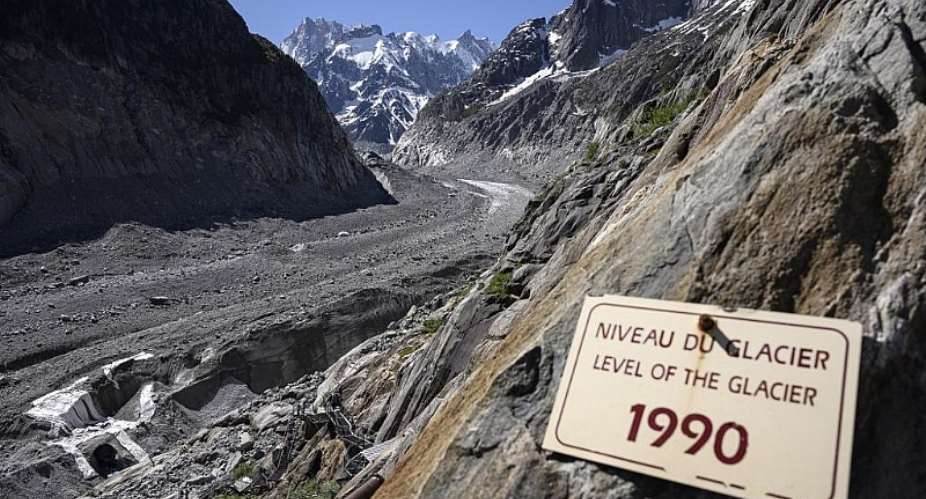Visitors arriving at the last tramstop before the 4,809-metre summit on the Mont Blanc mountain range in the French Alps are forced to take 20 steps further each year to reach the retreating "Mer de Glace" glacier.
Older visitors who return can recall a time when they could touch the ice just outside Montenvers tramstop in the shadow of the Mont Blanc summit.
A sign in the valley indicates: "Level of the Glacier: 1990." Now the ice has retreated dramatically.
On the glacier itself, the formerly pristine surface is now depressed and greyish.
A grotto visible through the glacier's blue frozen mass lit up with festive lights like a nightclub has become a popular stop for tourists.
Now workers have draped white tarpaulins held in place with large stones over the ice tunnel in a bid to protect it from the sun.
And mountaineers on the surrounding peaks follow a new ritual. Over the sound of mountain water, they stop more often to listen for the clatter of falling rocks on Europe's tallest peak.
The damage is increasingly clear from rockfalls that scar the mountainside and damage routes used by climbers visiting Mont Blanc.
The most spectacular of these rockfalls affected the Bonatti pillar, a massive rock column named after Italian climber Walter Bonatti, which collapsed in a cloud of dust in June 2005.
In 2011, smaller collapses also hit the same area and, four years later, landslides in the Couloir du Gouter prevented hundreds of mountaineers climbing Mont Blanc by the usual busiest routes. More falls have followed.
During the 1970s, the famed French alpinist and mountain guide Gaston Rebuffat noted Mont Blanc's hundred finest routes.
Half a century later, a team of researchers analysed snow conditions, ice and rock status, accessibility and risks on 95 of Rebuffat's routes.
The study published in June by Jacques Mourey, a doctoral student at the EDYTEM laboratory at the University of Savoie Mont Blanc, found 93 affected by climate change, 26 of them severely affected and three completely destroyed.
Among the changes that made these routes more complex and technically challenging are the appearance of bedrock, more fragile snow and ice and the widening of crevasses.





 Former Kotoko Player George Asare elected SRC President at PUG Law Faculty
Former Kotoko Player George Asare elected SRC President at PUG Law Faculty
 2024 elections: Consider ‘dumsor’ when casting your votes; NPP deserves less — P...
2024 elections: Consider ‘dumsor’ when casting your votes; NPP deserves less — P...
 You have no grounds to call Mahama incompetent; you’ve failed — Prof. Marfo blas...
You have no grounds to call Mahama incompetent; you’ve failed — Prof. Marfo blas...
 2024 elections: NPP creates better policies for people like us; we’ll vote for B...
2024 elections: NPP creates better policies for people like us; we’ll vote for B...
 Don’t exchange your life for wealth; a sparkle of fire can be your end — Gender ...
Don’t exchange your life for wealth; a sparkle of fire can be your end — Gender ...
 Ghana’s newly installed Poland train reportedly involved in accident while on a ...
Ghana’s newly installed Poland train reportedly involved in accident while on a ...
 Chieftaincy disputes: Government imposes 4pm to 7am curfew on Sampa township
Chieftaincy disputes: Government imposes 4pm to 7am curfew on Sampa township
 Franklin Cudjoe fumes at unaccountable wasteful executive living large at the ex...
Franklin Cudjoe fumes at unaccountable wasteful executive living large at the ex...
 I'll 'stoop too low' for votes; I'm never moved by your propaganda — Oquaye Jnr ...
I'll 'stoop too low' for votes; I'm never moved by your propaganda — Oquaye Jnr ...
 Kumasi Thermal Plant commissioning: I pray God opens the eyes of leaders who don...
Kumasi Thermal Plant commissioning: I pray God opens the eyes of leaders who don...
